2019 MERCEDES-BENZ CLA COUPE engine
[x] Cancel search: enginePage 147 of 330
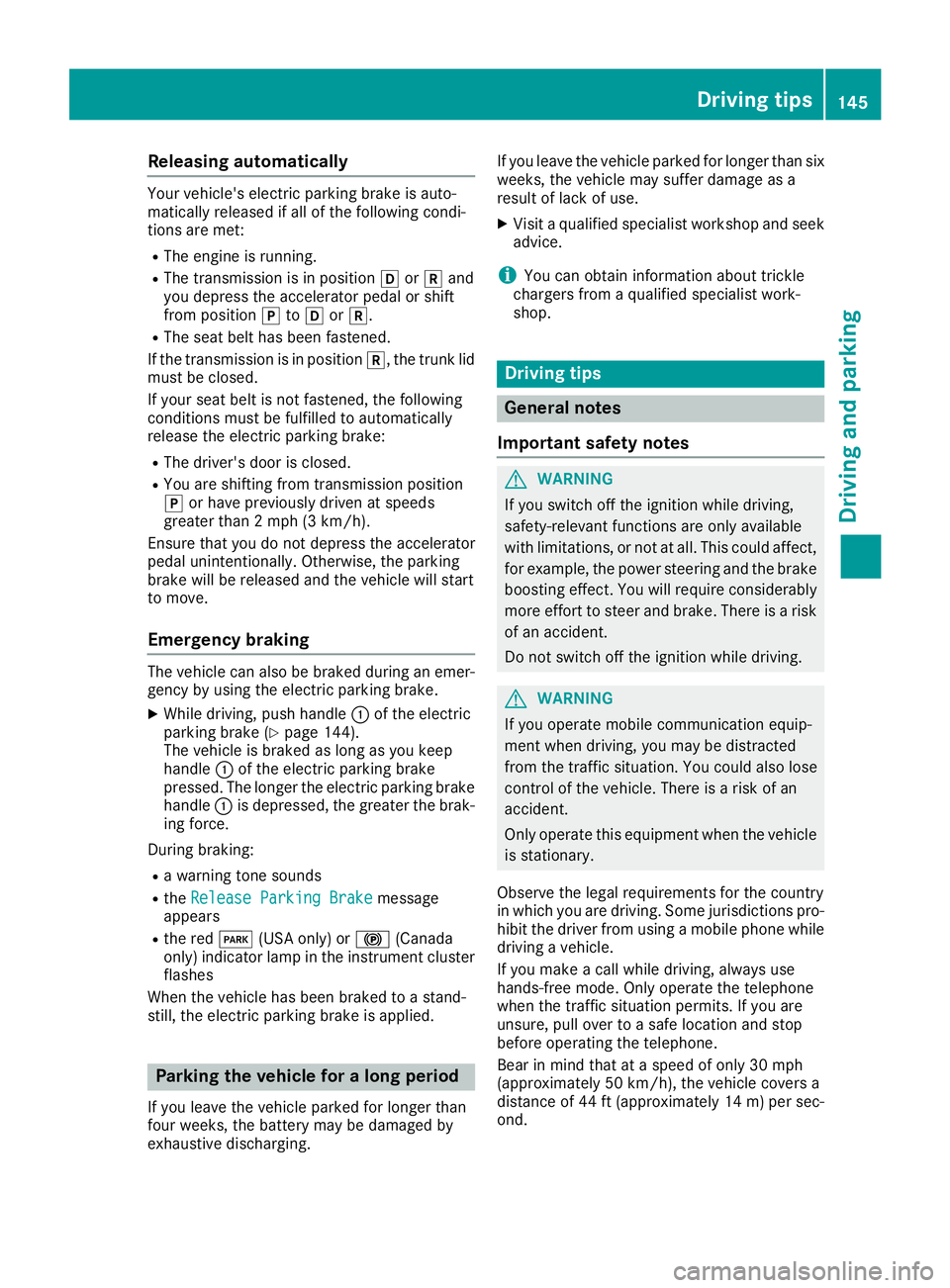
Rel
eas ingautomati cally Yo
ur veh icle's electri cpa rking brakeisau to-
mati callyrel eased ifallof the followi ng condi -
tions aremet:
R The engineisrunni ng.
R The trans missionis in pos ition 005B or005E and
yo udep ressthe acce lerato rped alor shi ft
from position 005D to005B or005E.
R The seatbel tha sbee nfas tened .
If the trans missionis in pos ition 005E, thetrunk lid
mus tbe closed .
If yo ur sea tbel tis not fastened ,the followi ng
condi tions mustbe fulfilled to automa tically
rel ease the electri cpa rking brake:
R The driver' sdoo ris clo sed .
R Yo uare shifting from transmissionpos ition
005D orhave pre viouslydri ven atspe eds
gre aterthan 2mph (3km/h ).
Ensur ethat youdo not depressthe acce lerato r
ped aluni ntentio nally.Othe rwise, the parking
bra kewillbe released and thevehiclewi llstar t
to move .
Eme rgencybraki ng The
vehiclecan also be bra ked during aneme r-
gency byusing the electri cpa rking brake.
X Whi ledri ving ,pu sh handl e0043 ofthe electri c
pa rking brake(Ypage 144 ).
The vehicleis bra ked aslong asyoukeep
ha ndl e0043 ofthe electri cpa rking brake
pre sse d.The longer theelectri cpa rking brake
ha ndl e0043 isdep ressed ,the greaterthe brak-
ing force .
Duri ngbra king:
R awa rning tonesounds
R the Rele asePark ingBrake Rele
asePark ingBrakemes sage
ap pea rs
R the red 0049 (USAonly)or 0024 (Cana da
only )ind icator lamp inthe instr umentclu ster
fla she s
Whe nthe vehicleha sbee nbra ked toastand -
stil l,the electri cpa rking brakeisap plied. Parki
ngthe vehic lefor alo ng peri od
If yo uleave thevehiclepa rked forlonger than
fou rwe eks, thebattery maybedamag edby
exha ustive discha rging. If
yo ule ave thevehiclepa rked forlonger thansix
we eks, thevehiclemay suffer damag eas a
res ultof lack ofuse.
X Vis itaqu alifi ed spe cialist wo rksho pand seek
ad vice .
i Yo
ucan obta ininfo rma tion abou ttrickl e
cha rgersfrom aqu alifi ed spe cialist wo rk-
sho p. Dri
vin gtips Gen
eral notes
Impo rtant safetynotes G
WARNI
NG
If yo uswi tch offthe igniti onwhile dri ving ,
sa fety -releva ntfuncti onsareonly availab le
wi th limita tions ,or not atall.Thi scou ldaff ect,
for exa mpl e,the pow erstee ringandthebrake
boo sting effect.Youwi llreq uire consi derably
more effortto stee rand brake. The reisaris k
of an acci dent.
Do not switch offthe igniti onwhile dri ving . G
WARNI
NG
If yo uope rate mobile commu nication equip-
ment when driving ,yo umay bedistra cted
from thetraff icsitu ation. Youcou ldalso lose
control ofthe vehicle. The reisaris kof an
acci dent.
Only operate thisequipment when the vehicle
is stati onary.
Obs erve thelega lreq uireme ntsforthe country
in wh ich youare driving .Some jurisdictions pro-
hib itthe driver from using amob ile pho newhile
dri ving aveh icle.
If yo umake acal lwh ile dri ving ,al wa ysuse
ha nds-fr eemod e.Only operate thetelepho ne
wh en the traff icsitu ation per mits .If yo uare
uns ure,pu llove rto asa fe locati onand stop
bef ore operatingthe telepho ne.
Bea rin mind thatataspe edofonly 30mph
(a pp roxi mate ly50 km/h ),the vehiclecove rsa
di stance of44 ft(app roxi mate ly14 m)per sec-
ond. Driving
tips
145Driving andparking Z
Page 149 of 330
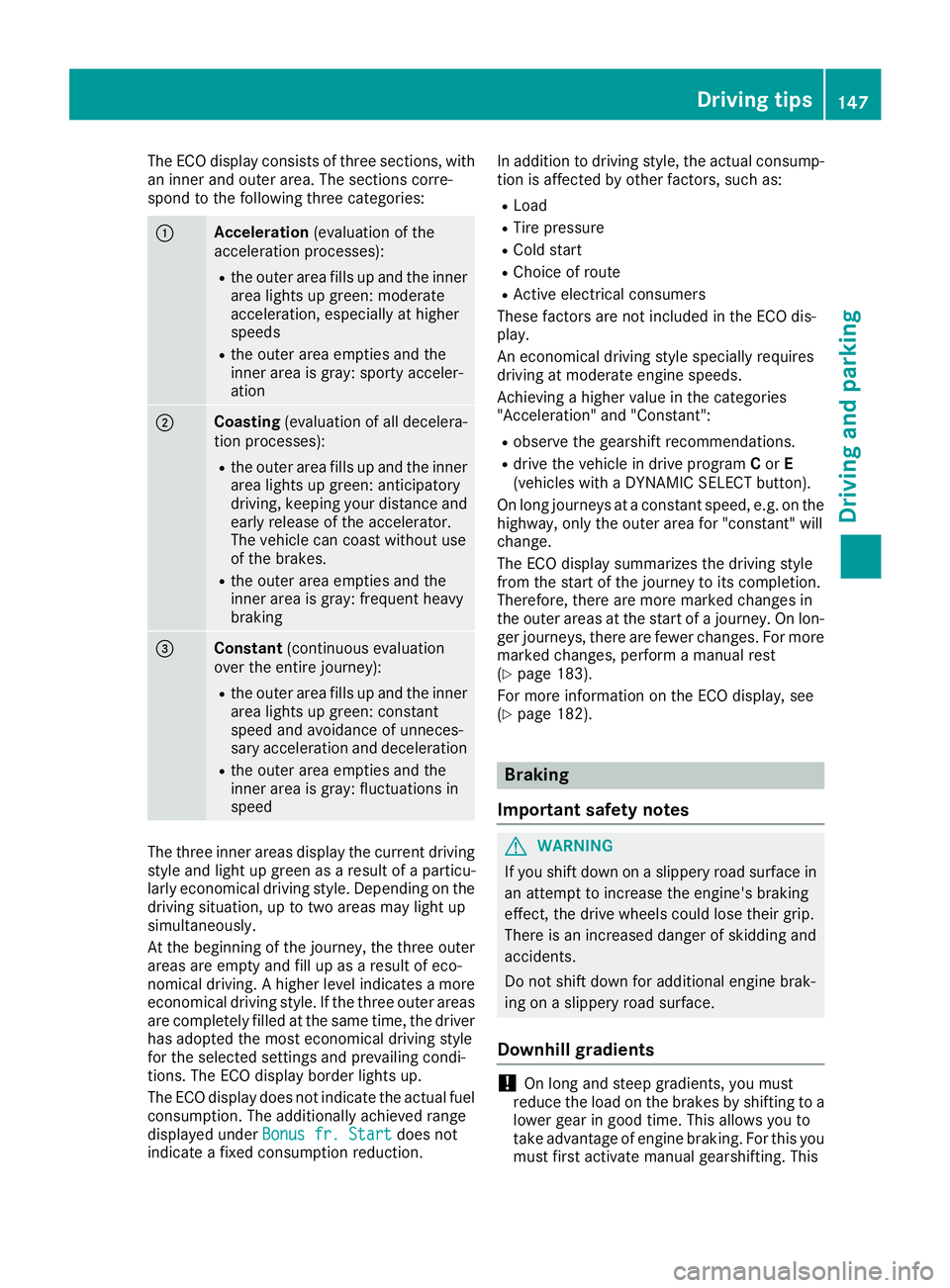
The
ECO display consistsof three section s,with
an inner andouter area.Thesection scorre-
spond tothe following threecategories: 0043
Acce
leration (evaluation ofthe
acceleration processes):
R the outer areafillsupand theinner
area lights upgreen: moderate
acceleration ,especially athigher
speeds
R the outer areaempties andthe
inner areaisgray: sporty acceler-
ation 0044
Coasting
(evaluation ofall decelera-
tion processes):
R the outer areafillsupand theinner
area lights upgreen: anticipator y
driving, keeping yourdistance and
early release ofthe accelerator.
The vehicle cancoast without use
of the brakes.
R the outer areaempties andthe
inner areaisgray: frequent heavy
braking 0087
Constant
(continuous evaluation
over theentir ejourney):
R the outer areafillsupand theinner
area lights upgreen: constant
speed andavoidance ofunneces -
sary acceleration anddeceleration
R the outer areaempties andthe
inner areaisgray: fluctuations in
speed The
three innerareas display thecurrent driving
style andlight upgreen asaresult ofaparticu-
larly econom icaldriving style.Dependin gon the
driving situation, uptotwo areas maylight up
simultaneously.
At the beginning ofthe journey, thethree outer
areas areempty andfillup asaresult ofeco-
nomical driving.Ahigher levelindicates amore
econom icaldriving style.Ifthe three outer areas
are completely filledatthe same time,thedriver
has adopted themost econom icaldriving style
for the selected settings andprevailing condi-
tions. TheECO display borderlightsup.
The ECO display doesnotindicate theactual fuel
consumpt ion.Theadditionally achievedrange
display edunder Bonus fr.Start Bonus
fr.Start doesnot
indicate afixed consumpt ionreduction . In
addition todriving style,theactual consump-
tion isaffect edbyother factors,such as:
R Load
R Tire pressure
R Cold start
R Choice ofroute
R Act ive electric alconsumer s
These factorsare not included inthe ECO dis-
play.
An econom icaldriving stylespecially requires
driving atmoderate enginespeeds.
Achievin gahigher valueinthe categories
"Accelerat ion"and"Constant ":
R observe thegearshift recommendations .
R drive thevehicle indrive program Cor E
(vehicles withaDYNA MICSELECT button ).
On long journeys ataconst antspeed, e.g.onthe
highway, onlytheouter areafor"const ant"will
change.
The ECO display summarizes thedriving style
from thestart ofthe journey toits completion .
Therefore, therearemore marked changes in
the outer areas atthe start ofajourney. Onlon-
ger journeys, therearefewer changes. Formore
marked changes, performamanual rest
(Y page 183).
For more inform ationonthe ECO display ,see
(Y page 182). Br
aking
Import antsafety notes G
WARNIN
G
If you shift down onaslippery roadsurface in
an attempt toincrease theengine's braking
effect ,the drive wheels couldlosetheir grip.
There isan increased dangerofskidding and
accident s.
Do not shift down foradditional enginebrak-
ing onaslippery roadsurface.
Dow nhill gradients !
On
long andsteep gradients, youmust
reduce theload onthe brakes byshiftin gto a
lower gearingood time. Thisallows youto
take advantage ofengine braking. Forthis you
must firstactivate manualgearshifting .This Driving
tips
147Driving andparking Z
Page 150 of 330
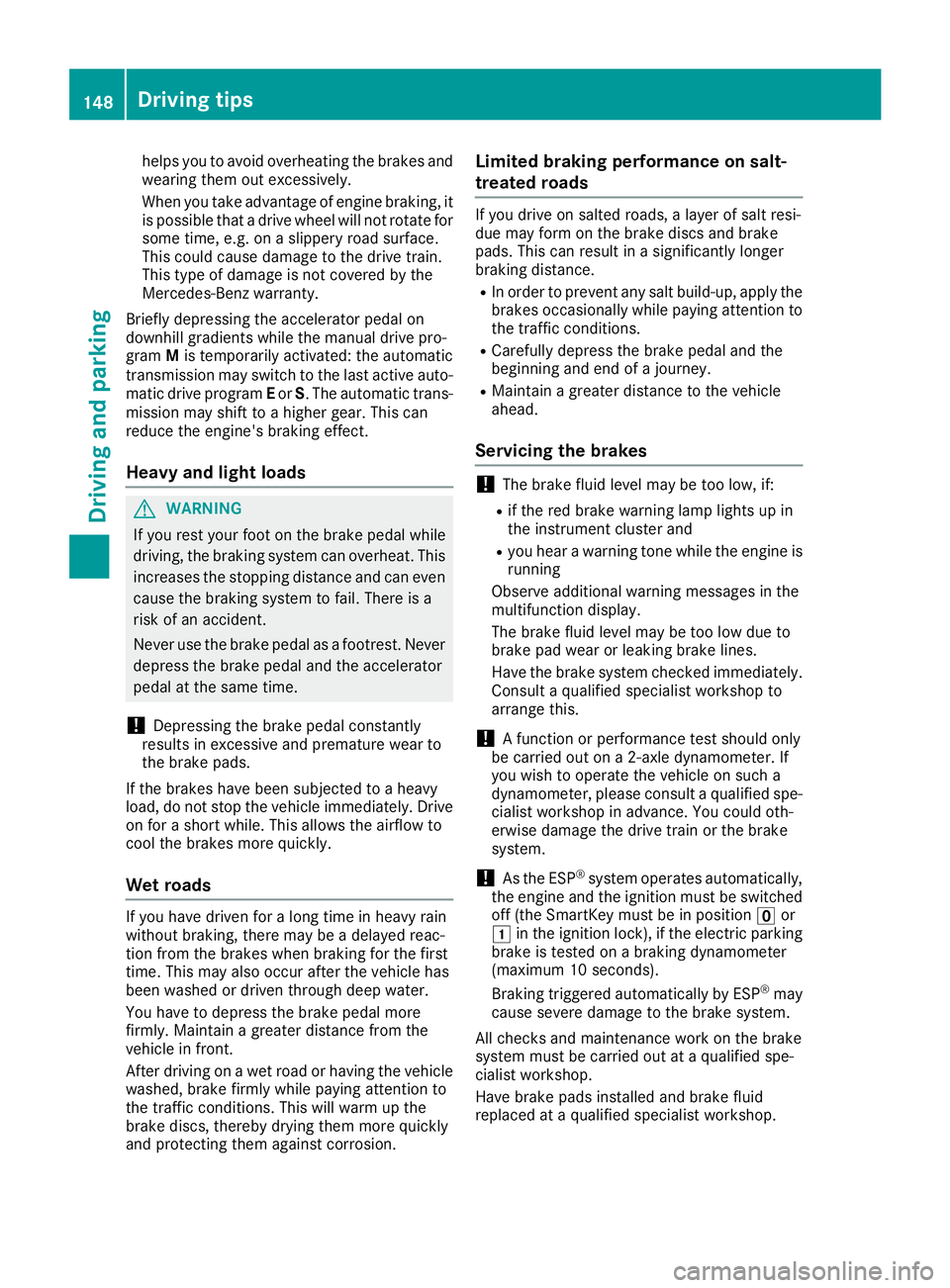
helps
youtoavoid overheating thebrakes and
wearing themoutexcessively.
When youtake advantage ofengine braking, it
is possible thatadrive wheel willnotrotate for
some time,e.g.onaslippery roadsurface.
This could cause damage tothe drive train.
This type ofdamage isnot covered bythe
Mercedes-Ben zwarranty.
Briefly depressing theaccelerator pedalon
downhill gradients whilethemanual drivepro-
gram Mistemporarily activated:theautomatic
transmission mayswitch tothe last active auto-
matic driveprogram Eor S.The automatic trans-
mission mayshift toahigher gear.Thiscan
reduce theengine's brakingeffect.
Heavy andlight loads G
WARNING
If you rest your footonthe brake pedalwhile
driving, thebraking systemcanoverheat. This
increases thestopping distanceandcaneven
cause thebraking systemtofail. There isa
risk ofan accident.
Never usethebrake pedalasafootrest .Never
depress thebrake pedalandtheaccelerator
pedal atthe same time.
! Depressing
thebrake pedalconstantly
results inexcessive andpremature wearto
the brake pads.
If the brakes havebeen subjected toaheavy
load, donot stop thevehicle immediately. Drive
on for ashort while. Thisallow sthe airflow to
cool thebrakes morequickly.
Wet roads If
you have driven foralong time inheavy rain
without braking, theremaybeadelay edreac-
tion from thebrakes whenbraking forthe first
time. Thismay alsooccur afterthevehicle has
been washed ordriven through deepwater.
You have todepress thebrake pedalmore
firmly. Maintain agreater distance fromthe
vehicle infront .
Aft erdriving onawet road orhaving thevehicle
washed, brakefirmlywhilepayingattent ionto
the traffic conditions .This willwarm upthe
brake discs, thereby dryingthemmore quickly
and protect ingthem against corrosion. Limited
braking performanceonsalt-
treat edroads If
you drive onsalted roads, alaye rof salt resi-
due may form onthe brake discsandbrake
pads. Thiscanresult inasignificantly longer
braking distance.
R Inorder toprevent anysalt build -up,apply the
brakes occasionally whilepayingattent ionto
the traffic conditions .
R Carefull ydepress thebrake pedalandthe
beginning andend ofajourney.
R Maintain agreater distance tothe vehicle
ahead.
Servicing thebrakes !
The
brake fluidlevel maybetoo low, if:
R ifthe red brake warning lamplights upin
the instrumen tcluster and
R you hear awarning tonewhile theengine is
running
Observe additional warningmessages inthe
multifunction display.
The brake fluidlevel maybetoo low due to
brake padwear orleaking brakelines.
Have thebrake system checkedimmediately.
Consult aqual ified specialist workshop to
arrange this.
! A
funct ionorperformance testshould only
be carried outona2-axle dynamometer. If
you wish tooperate thevehicle onsuch a
dynamometer, pleaseconsult aqual ified spe-
cialist workshop inadvance. Youcould oth-
erwise damage thedrive trainorthe brake
system.
! As
the ESP ®
system operates automatically ,
the engine andtheignition mustbeswitched
off (the SmartKey mustbeinposition 0092or
0047 inthe ignition lock),ifthe electric parking
brake istested onabraking dynamometer
(maximum 10seconds).
Braking triggered automatically byESP ®
may
cause severe damage tothe brake system.
All check sand maintenanc ework onthe brake
system mustbecarried outataqual ified spe-
cialist workshop.
Have brake padsinstalled andbrake fluid
replaced ataqual ified specialist workshop. 148
Driving
tipsDriving andparking
Page 151 of 330
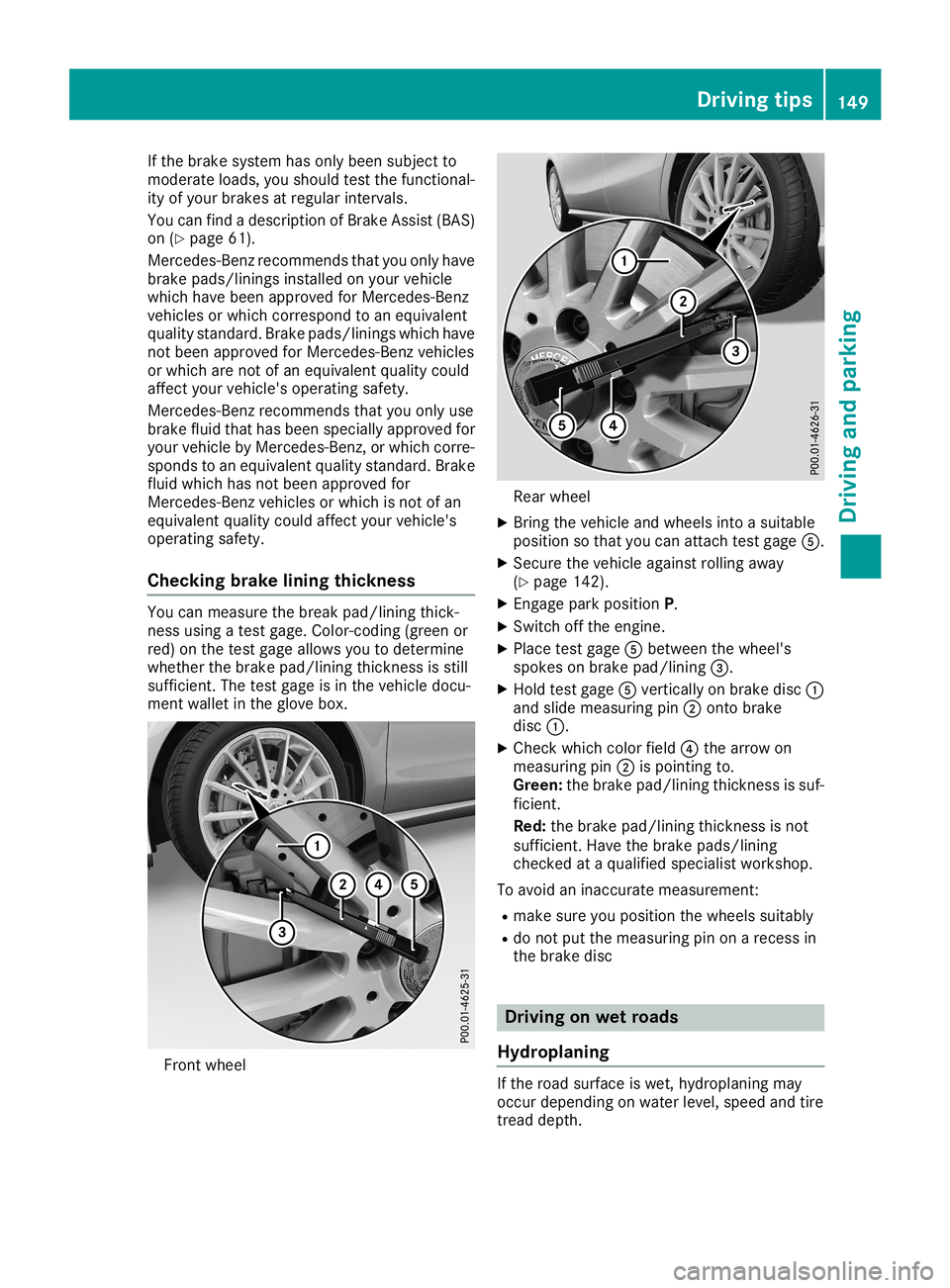
If
the brake system hasonly been subject to
modera teload s,you shoul dtest thefunctional-
ity ofyou rbrakes atregul arintervals.
You canfind adescriptio nof Brake Assist (BAS)
on (Ypage 61).
Mercedes-Benz recommendsthatyouonly have
brake pads/linings installedon you rvehicle
which havebeen appro vedforMercedes-Benz
vehicle sor which correspond toan equi valent
qua litystandard. Brakepads/linings whichhave
not been appro vedforMercedes-Benz vehicles
or which arenot ofan equi valent qualitycould
affect yourvehicle 'sopera tingsafety.
Mercedes-Benz recommendsthatyouonly use
brake fluidthat hasbeen specia llyappro vedfor
you rvehicle byMercedes-Benz, orwhich corre-
sponds toan equi valent qualitystandard. Brake
flui dwhich hasnotbeen appro vedfor
Mercedes-Benz vehiclesor which isnot ofan
equi valent qualitycould affect yourvehicle 's
opera tingsafety.
Chec kingbrake liningthickne ss You
canmeasu rethe break pad/liningthick-
ness using atest gage .Colo r-coding (greenor
red) onthe test gage allows youtodetermine
whether thebrake pad/liningthickness isstill
sufficie nt.The test gage isin the vehicle docu-
ment walletinthe glove box. Front
wheel Rea
rwheel
X Bring thevehicle andwheel sinto asuita ble
positio nso that youcan attach testgage 0083.
X Secure thevehicle against rollingawa y
(Y page 142).
X Engage parkpositio nP.
X Switch offthe engine.
X Pla cetest gage 0083betwee nthe wheel 's
spokes onbrake pad/lining0087.
X Hold testgage 0083verticall yon brake disc0043
and slidemeasu ringpin0044onto brake
disc 0043.
X Check whichcolorfield0085the arrow on
measu ringpin0044ispointing to.
Green: thebrake pad/liningthickness issuf-
ficient.
Red: thebrake pad/liningthickness isnot
sufficie nt.Have thebrake pads/lining
checked ataqua lifiedspecia listworkshop.
To avoid aninaccurate measurement:
R make sureyoupositio nthe wheel ssuita bly
R do not putthemeasu ringpinonarecess in
the brake disc Drivin
gon wetroads
Hydroplaning If
the road surface iswet, hydro planing may
occur dependi ngon water level,speed andtire
tread depth. Drivi
ngtips
149Drivingand parking Z
Page 152 of 330

For
this reason, inthe event ofhea vyrainor in
condi tions inwhi chhydrop laning mayoccur ,
yo umus tdri ve inthe follow ing manne r:
R low eryour spe ed
R avo idruts
R avo idsud den steer ingmove ments
R bra kecare fully
Dri vin gon floode droads !
Do
not drive throu ghfloode dare as. Che ck
the depthofany water befo redri ving throu gh
it. Drive slowlythrou ghstand ingwater. Oth-
erw ise,wa ter cou ldenter thevehi cleinteri or
or engi necompa rtment. Itcan then damag e
the engi ne's orautoma tictransmi ssion's
ele ctronic components.Itcan also be sucke d
in by the engi ne's airintake connectio nand
cau seengi nedamag e. Win
terdrivi ng G
WARNI
NG
If yo ushi ftdow non asli ppe ryroa dsur face in
an attemp tto increa sethe engi ne's braking
effe ct,the drive whe elscou ldlos ethei rgri p.
The reisan increa seddanger ofskid ding and
acci dents.
Do not shiftdow nfor additi onal enginebra k-
ing onasli ppe ryroa dsur face . G
DA
NGER
If the exha ustpipeis blo cked oradequ ate
ventil ation isnot possible, poi sonou sga ses
such ascarb onmonoxi de(CO) may enter the
vehi cle. Thisis the case ,e.g. ifthe vehi cle
beco mestrapped insnow .The reisarisk of
fata linjur y.
If yo ulea vethe engi neorthe auxili ary hea ting
runni ng,make surethe exha ustpipeand area
aro und thevehi cleare clea rof snow .To
ensu rean adequ atesupplyoffresh air, ope na
wi ndow onthe sideof the vehi clethat isnot
faci nginto thewind.
Have your vehi clewinter-pro ofedataqu alifi ed
spe cialist wor kshop atthe onset ofwinter. Drive
particu larly care fullyon slippe ryroa dsur -
face s.Avoid sudden acce leration, steer ingand
bra king mane uvers.Do not use cruisecontrol or
Active DistanceAssistDISTR ONIC.
If the vehi clethrea tenstoskid orcannot be
stopp edwhe nmovi ngatlow speed:
X Shift thetransmi ssion topos ition005C.
X Try tobring the vehi cleund ercontrol using
corre ctive steering.
The outsid etempe ratureindi cator isnot
des igne dto serve asan ice-w arningdevi ceand
is there foreunsu itable forthat purpos e.
Cha nges inthe outsid etempe ratureare dis-
pla yedafte ra shor tdel ay.
Indi cated tempe raturesjust above thefree zing
poi ntdo not guara ntee thattheroadsur face is
free ofice. The roadmay stillbe icy,esp ecia lly in
woo ded areasoron bridge s.
You shou ldpa yspe cialattenti ontoroa dcondi -
tions whentempe raturesare around freezing
poi nt.
For more informationondriving with snow
chai ns,see (Ypage 293).
For more informationondriving with sum mer
tires ,see (Ypage 292 ).
Obs erve thenotes inthe "Winter operation" sec-
tion (Ypage 292 ). Dri
vin gsys tems Crui
secontrol
Gen eral notes Cru
isecontrol maintains aconsta ntroa dspe ed
for you. Itbra kes automa tically in orde rto avo id
excee dingthesetspeed. Onlong andsteep
dow nhillgra dients, especia lly if the vehi cleis
la den, youmus tsel ect alow gearin goo dtime.
You need toshi ftmanu ally usi ng the steer ing
whe elpa ddl eshi fters beforeha nd.Bydoing so,
yo uwi llmake useofthe braking effectof the
engi ne.Thisrel iev es the loadon the brakesys-
tem andprevents thebrakes from overheating
and wearing too quickly .
Whe nthe engi neisrunni ng,youcan usethe
crui secontrol leverto limit the speedtoany
spe edbetw een20mph (30km/h )and thetech-
nica lly per mitted maximum speedofthe vehi cle.
Use cruisecontrol ifroa dand traffi ccondi tions
make itap prop riate to mai ntain astea dyspe ed
for aprol onge dper iod. 150
Dri
vin gsys temsDrivin gand parking
Page 154 of 330
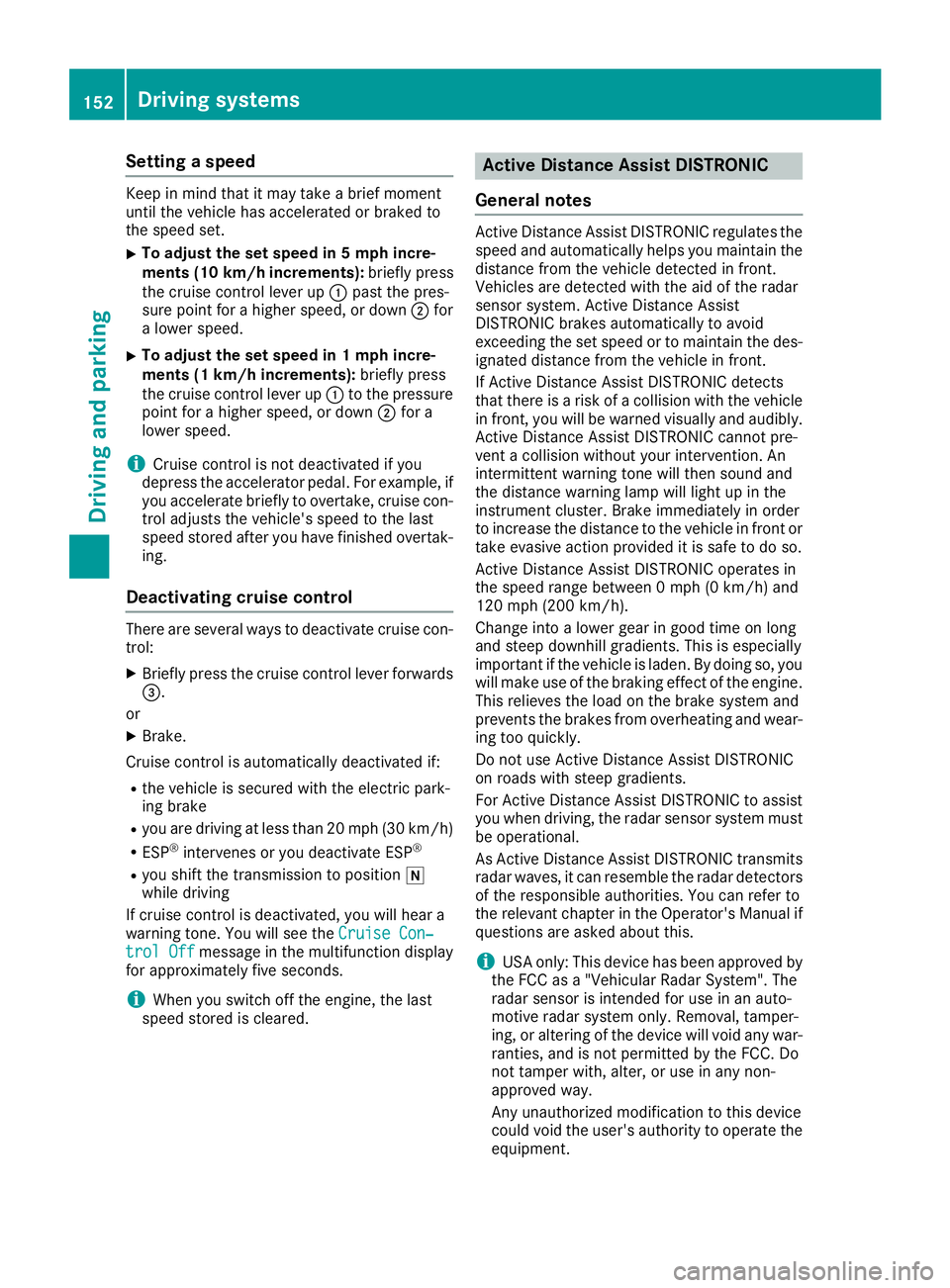
Setting
aspeed Keep
inmind thatitmay take abrief moment
until thevehicle hasaccelerated orbraked to
the speed set.
X To
adj ust the setspeed in5mph incre-
ments (10km/h increment s):briefly press
the cruise control lever up0043 past thepres-
sure point forahigher speed, ordown 0044for
a lower speed.
X To
adj ust the setspeed in1mp hincre-
ments (1km/h increment s):briefly press
the cruise control lever up0043 tothe pressure
point forahigher speed, ordown 0044for a
lower speed.
i Cruise
control isnot deactiv atedifyou
depress theaccelerat orpedal. Forexample, if
you accelerat ebriefly toovert ake,cruise con-
trol adjusts thevehicle's speedtothe last
speed storedafter youhave finished overtak-
ing.
Deactivat ingcruise control There
areseveral waystodeactiv atecruise con-
trol:
X Briefly pressthecruise control lever forwards
0087.
or X Brak e.
Cruise control isautomatic allydeactiv atedif:
R the vehicle issecured withtheelectr icpark-
ing brake
R you aredriving atless than 20mph (30km/ h)
R ESP ®
inte rvenes oryoude acti vate ESP ®
R youshi ftthe transmi ssion topositio n005C
wh ile dri vin g
If cru ise contro lis de acti vated ,yo uwi llhe ar a
wa rning tone .Yo uwi llsee theCruise Con‐ Cru
ise Con‐
tro lOff tro
lOff message inthe multifu nctio ndisp lay
for appro xim atelyfiv esec ond s.
i Wh
enyousw itch offthe engine,the last
sp ee dstor ediscle ared . Ac
tiv eDi stan ceAssist DISTRO NIC
Ge neral notes Activ
eDis tance AssistDISTR ONICreg ulate sthe
sp ee dand automa tically he lpsyo uma inta inthe
di sta nce fromthe vehiclede tecte din fro nt.
Veh icles arede tecte dwi th the aid of the rada r
sen sor system .Activ eDis tance Assist
DISTR ONICbra kes automa tically to avoid
exce eding the setspee dor toma inta inthe des-
ig nate ddista nce fromthe vehiclein fro nt.
If Activ eDis tance AssistDISTR ONICde tects
tha tthe reisaris kof acol lisi on with the vehicle
in fro nt, youwi llbe warned visually and audibly.
Activ eDis tance AssistDISTR ONICcanno tpre -
vent acol lisi on withou tyo ur inte rventio n.An
inte rmittent warning tone willthe nsou ndand
the dista nce warning lamp willlight upinthe
ins trument cluster .Bra keimm ediatel yin ord er
to incr ease the dista nce tothe vehiclein fro ntor
take evasive acti onpro vided itis sa fe to do so.
Activ eDis tance AssistDISTR ONICop era tes in
the spee dra nge betwe en0mph (0km/h )and
120 mph (200km/h ).
Ch ang einto alowe rge ar ingo od time onlong
and steepdo wnh ill gra dients .Thi sis esp ecially
imp orta ntifthe vehicleis lade n.By doing so,you
wi llma keuseof the braking effect ofthe eng ine.
Thi srel ieves theload on the brakesystem and
pre vents thebrakes fromove rheating and wear-
ing too quickl y.
Do not useActiv eDis tance AssistDISTR ONIC
on roa dswith stee pgra dients .
For Activ eDis tance AssistDISTR ONICto assist
yo uwh en drivin g,the rada rsen sor system must
be opera tional .
As Activ eDis tance AssistDISTR ONICtra nsmi ts
ra da rwa ves ,it can resemb lethe rada rde tecto rs
of the responsi ble au thor ities. Youcan referto
the releva ntcha pterin the Opera tor' sMa nua lif
qu esti ons areas ked abou tthi s.
i USA
only:Thi sde vic eha sbe en appro ved by
the FCC asa"V eh icu larRa darSys tem" .The
ra da rsen sor isinte ndedfor usein an auto-
moti verada rsy stem only.Re mov al,tam per-
ing ,or alteri ngofthe devic ewi llvoi dany war-
ra ntie s,and isnot permi tted bythe FCC .Do
not tamperwi th, alter, orusein any non-
ap pro ved way.
Any unauthorized mod ificati ontothisde vic e
cou ldvoi dthe user' sau thor itytoopera tethe
eq uipme nt. 15
2 Dr
ivi ng system sDrivi ng andparki ng
Page 156 of 330
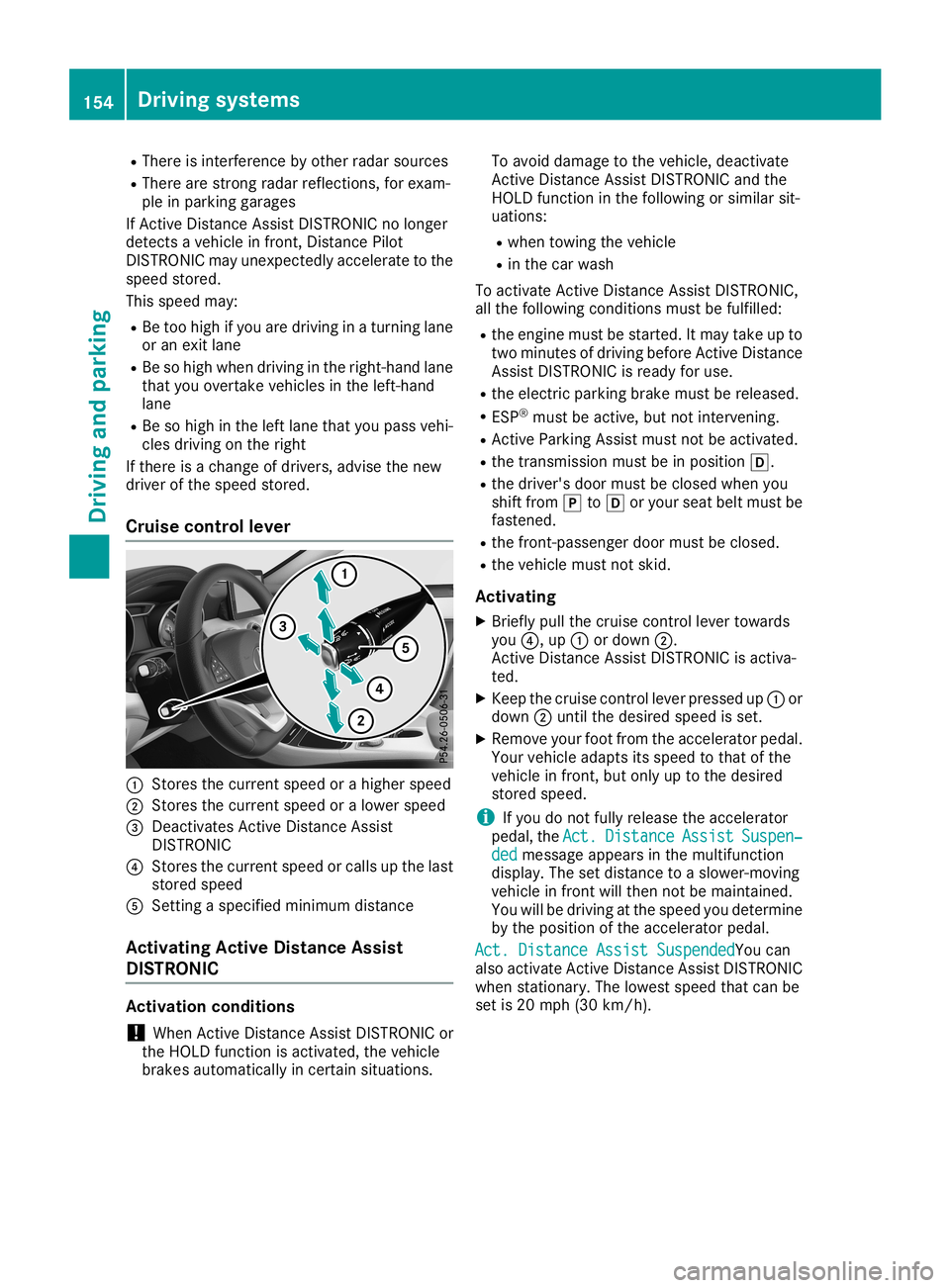
R
There isinter ferenc eby other radarsources
R There arestron gradar reflect ions,forexam-
ple inparking garages
If Act ive Distan ceAssist DISTRONIC nolonger
detect sa vehicle infront ,Distan cePilot
DIS TRONIC mayunexpect edlyaccelerate tothe
speed stored.
This speed may:
R Be too high ifyou aredriving inaturnin glane
or an exit lane
R Be sohigh when driving inthe right- hand lane
that youovertak evehicles inthe left- hand
lane
R Be sohigh inthe left lane thatyoupass vehi-
cles driving onthe right
If there isachange ofdrivers, advisethenew
driver ofthe speed stored.
Cruise control lever 0043
Stor esthe current speedorahigher speed
0044 Stor esthe current speedoralower speed
0087 Deact ivates Active Distan ceAssist
DIS TRONIC
0085 Stor esthe current speedorcalls upthe last
stored speed
0083 Sett ingaspecified minimum distance
Activating ActiveDistance Assist
DISTRONIC Activation
conditions
! When
Active Distan ceAssist DISTRONIC or
the HOLD functionisactivated, thevehicle
brakes automatically incert ainsituations. To
avoid damage tothe vehicle, deactivate
Act ive Distan ceAssist DISTRONIC andthe
HOLD functioninthe following orsimilar sit-
uations:
R when towing thevehicle
R in the carwash
To activate Active Distan ceAssist DISTRONIC,
all the following conditionsmust befulfilled:
R the engine mustbestart ed.Itmay take upto
two minutes ofdriving beforeActiveDistan ce
Assist DISTRONIC isready foruse.
R the electric parking brakemustbereleased.
R ESP ®
must beactive, butnot inter vening.
R Act ive Parking Assistmustnotbeactivated.
R the trans mission mustbeinposition 005B.
R the driver's doormust beclosed whenyou
shift from 005Dto005B oryour seatbeltmust be
fasten ed.
R the front -passenger doormust beclosed.
R the vehicle mustnotskid.
Activating
X Briefly pullthecruise controllever towards
you 0085,up0043 ordown 0044.
Act ive Distan ceAssist DISTRONIC isactiva-
ted.
X Keep thecruise controllever pressed up0043 or
down 0044until thedesired speedisset.
X Remove yourfootfrom theaccelerator pedal.
Your vehicle adaptsitsspeed tothat ofthe
vehicle infront ,but only uptothe desired
stored speed.
i If
you donot fully release theaccelerator
pedal, theAct. Act.
Distance Distance
Assist Assist
Suspen‐ Suspen‐
ded ded
message appearsinthe multifunct ion
display .The setdistance toaslower-movin g
vehicle infront willthen notbemaintained.
You willbedriving atthe speed youdetermin e
by the position ofthe accelerator pedal.
Act. Distance AssistSuspended Act.
Distance AssistSuspendedYou can
also activate Active Distan ceAssist DISTRONIC
when station ary.Thelowest speedthatcanbe
set is20 mph (30km/ h). 154
Driving
systemsDriving andparking
Page 158 of 330
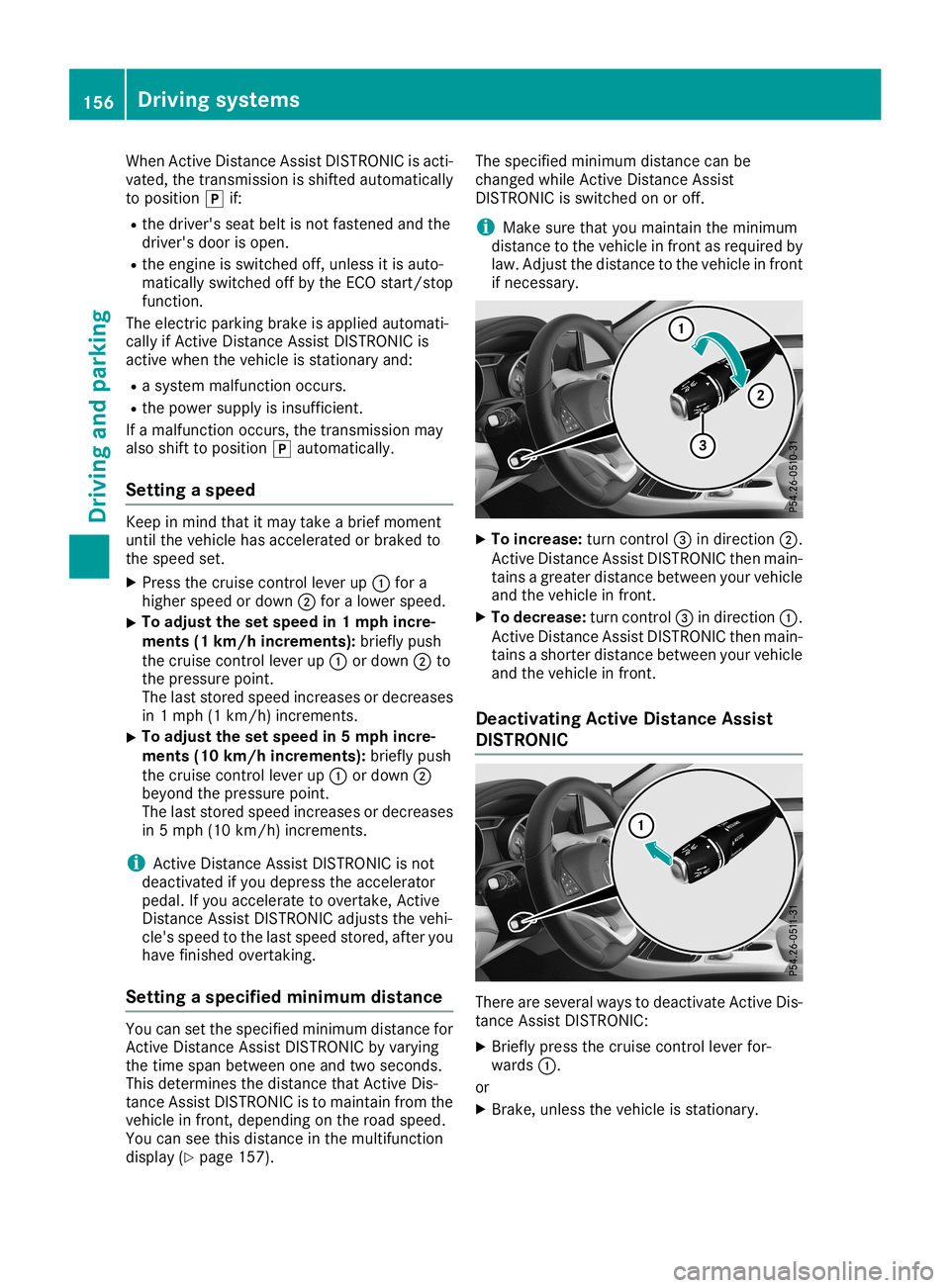
When
ActiveDist ance Assist DISTRONIC isacti-
vated, thetran smission isshifted automatically
to position 005Dif:
R the driver's seatbeltisnot fasten edand the
driver's doorisopen.
R the engine isswitched off,unless itis auto-
matically switchedoffbythe ECO start/stop
funct ion.
The electr icparking brakeisapplied automati-
cally ifAct ive Dist ance Assist DISTRONIC is
active whenthevehicle isstation aryand:
R asystem malfunct ionoccurs .
R the power supply isinsuffic ient.
If amalfunct ionoccurs ,the tran smission may
also shift toposition 005Dautomatically.
Setting aspeed Keep
inmind thatitmay take abrief momen t
until thevehicle hasaccelerat edorbraked to
the speed set.
X Press thecruise controllever up0043 for a
higher speedordown 0044for alower speed.
X To
adj ust the setspeed in1mph incre-
ments (1km/h increments): brieflypush
the cruise controllever up0043 ordown 0044to
the pressure point.
The laststored speedincreases ordecreases
in 1mph (1km/ h)incr ement s.
X To
adj ust the setspeed in5mph incre-
ments (10km/h increments): brieflypush
the cruise controllever up0043 ordown 0044
beyond thepressure point.
The laststored speedincreases ordecreases
in 5mph (10km/ h)incr ement s.
i Act
ive Dist ance Assist DISTRONIC isnot
deactivat edifyou depress theaccelerat or
pedal. Ifyou accelerat eto overt ake,Active
Dist ance Assist DISTRONIC adjuststhevehi-
cle's speed tothe last speed stored, afteryou
have finished overtaking.
Setting aspecified minimumdista nce You
cansetthe specified minimum distancefor
Act ive Dist ance Assist DISTRONIC byvarying
the time span between oneandtwosecon ds.
This determ inesthedistanc ethat Active Dis-
tanc eAssist DISTRONIC isto maintain fromthe
vehicle infron t,depending onthe road speed.
You canseethis distanc ein the multifunc tion
display (Ypage 157). The
specified minimum distancecan be
changed whileActive Dist ance Assist
DIS TRONIC isswitched onoroff.
i Make
surethatyoumaintain theminimum
distanc eto the vehicle infron tas required by
law. Adjust the distanc eto the vehicle infron t
if neces sary. X
To increase: turncontrol0087 indirect ion0044.
Act iveDist ance Assist DISTRONIC thenmain-
tains agreater distancebetween yourvehicle
and thevehicle infron t.
X To decrease: turncontrol0087 indirect ion0043.
Act iveDist ance Assist DISTRONIC thenmain-
tains ashort erdistanc ebetween yourvehicle
and thevehicle infron t.
Deactivating ActiveDistance Assist
DISTRONIC There
areseveral waystodeactivat eAct iveDis-
tanc eAssist DISTRONIC:
X Briefly pressthecruise controllever for-
wards 0043.
or X Brake, unless thevehicle isstation ary. 156
Driving
systemsDriving andparking